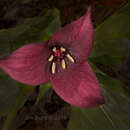en
names in breadcrumbs


Trillium vaseyi (lat. Trillium vaseyi) — melantkimilər fəsiləsinin trillium cinsinə aid bitki növü.
Trillium vaseyi (lat. Trillium vaseyi) — melantkimilər fəsiləsinin trillium cinsinə aid bitki növü.
Trillium vaseyi, the sweet wakerobin[5] or sweet beth, is a spring flowering perennial plant which is found only in the southeastern United States, primarily in the southern part of the Appalachian Mountains but with a few populations farther south.[4][6][7][8][9]
Sweet wakerobin has among the largest flowers in the trillium family, with red petals up to 7 cm long. It grows in rich woods, sometimes on riverbanks but other times on steep slopes.[10]
Trillium vaseyi was described by American botanist Thomas Grant Harbison in 1901.[3]
As of April 2023, the global conservation status of Trillium vaseyi is listed as vulnerable and near threatened by NatureServe and IUCN (resp.).[1][2] It is critically imperiled in Alabama.
Trillium vaseyi, the sweet wakerobin or sweet beth, is a spring flowering perennial plant which is found only in the southeastern United States, primarily in the southern part of the Appalachian Mountains but with a few populations farther south.
Trillium vaseyi est une plante herbacée, vivace et rhizomateuse de la famille des Liliaceae (classification classique) ou des Melanthiaceae (classification APG II, 2003).
Cette grande espèce, du sud-est des États-Unis ressemble au Trille rouge. Elle fleurit à la fin du printemps dans les forêts fraîches et le long des rivières. La fleur à odeur agréable, de 6 à 13 cm de diamètre à larges pétales rouge sombre, est portée par un pédoncule légèrement recourbé. Les feuilles rhomboïdes sont acuminées. Le fruit est une baie rouge sombre.
Montagnes des Carolines, du Tennessee, de la Géorgie et de l’Alabama.
En anglais son nom est Sweet trillium.
Trillium vaseyi est une plante herbacée, vivace et rhizomateuse de la famille des Liliaceae (classification classique) ou des Melanthiaceae (classification APG II, 2003).
Trillium vaseyi là một loài thực vật có hoa trong họ Melanthiaceae. Loài này được Harb. miêu tả khoa học đầu tiên năm 1902.[1]
Trillium vaseyi là một loài thực vật có hoa trong họ Melanthiaceae. Loài này được Harb. miêu tả khoa học đầu tiên năm 1902.